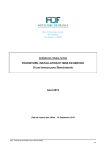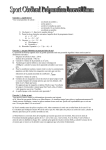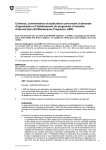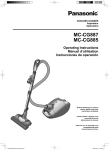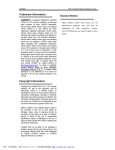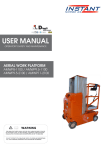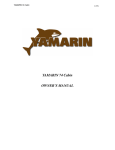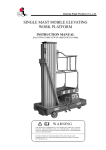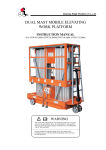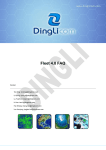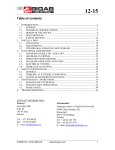Download Operation Service Manual
Transcript
ELECTRIC SCISSOR LIFTS Operation Service Manual JCPT0808HD JCPT1008HD JCPT1012HD JCPT1212HD JCPT0808DC JCPT1008DC JCPT1012DC JCPT1212DC WARNING THE MANUFACTURER SHALL NOT BE HELD LIABLE IN CASE OF FAULTS OR ACCIDENTS DUE TO NEGLIGENCE, INCAPACITY, INSTALLATION BY UNQUALIFIED TECHNICIANS AND IMPROPER USE OF THE MACHINE. DO NOT OPERATE THIS MACHINE UNTIL YOU READ AND UNDERSTAND ALL THE DANGERS, WARNINGS AND CAUTIONS IN THIS MANUAL Owners, Users and operators: Important We appreciate your choice of our machine for your application. Our number one priority is user safety, which is best achieved by our joint efforts. We feel that you make a major contribution to safety if you, as the equipment users and operators: Read, understand and obey these safety rules and operating instructions before operating this machine. Only trained and authorized personnel shall be permitted to operate this machine. This manual should be considered a permanent part of your machine and should remain with the machine at all times. If you have any questions, please call DINGLI Machinery. Contents 1. Comply with employer, job site and governmental rules. 2. Read, understand and follow the instructions in this and other manuals supplied with this machine. 3. Use good safe work practices in a commonsense way. 4. 0nly have trained / certified operators, directed by informed and knowledgeable supervision, running the machine. Page Safety Rules 1 Control panel 12 Pre-operation Inspection 15 Maintenance 17 Function Tests 19 Workplace Inspection 24 Operating Instructions 25 Transport and Lifting Instructions 32 Decals 36 Specifications 38 Schematic 46 If there is anything in this manual that is not clear or which you believe should be added, please contact us. Contact us: i Safety Rules Decal Legend Danger DINGLI product decals use symbols, color coding and signal words to identify the following: Failure to obey the instructions and safety rules in this manual will result in death or serious injury. Safety alert symbol—used to alert personnel to potential personal injury hazards. Obey all safety messages that follow this symbol to avoid possible injury or death. Do Not Operate Unless: √ You learn and practice the principles of safe Red—used to indicate the presence of an imminently hazardous situation which, if not avoided, will result in death or serious injury. machine operation contained in this operator's manual. 1 Avoid hazardous situations. Know and understand the safety rules before going on to the next section. Orange—used to indicate the presence of a potentially hazardous situation which, if not avoided, could result in death or serious injury. 2 Always perform a pre-operation inspection. 3 Always perform function tests prior to use. Yellow with safety alert symbolused to indicate the presence of a potentially hazardous situation which, if not avoided, may cause minor or moderate injury. 4 Inspect the workplace. 5 Only use the machine as it was intended. √ You read, understand and obey the manufacturer's instructions and safety rules— safety and operator's manuals and machine decals. √ Yellow without safety alert symbol—used to indicate the presence of a potentially hazardous situation which, if not avoided, may result in property damage. You read, understand and obey employer's safety rules and worksite regulations. √ You read, understand and obey all applicable governmental regulations. √ You are properly trained to safely operate the machine. 1 Safety Rules Personal Safety Intended Use This machine is intended to be used only to lift personnel, along with their tools and materials to an aerial work site. Fall Protection Personal fall protection equipment (PFPE) is not required when operating this machine. If PFPE is required by job site or employer rules, the following shall apply: Safety Sign Maintenance Replace any missing or damaged safety signs. Keep operator safety in mind at all times. Use mild soap and water to clean safety signs. Do not use solvent-based cleaners because they may damage the safety sign material. All PFPE must comply with applicable governmental regulations, and must be inspected and used in accordance with the manufacturer’s instructions. 2 Safety Rules Electrocution Hazards Tip-over Hazards This machine is not electrically insulated and will not provide protection from contact with or proximity to electrical current. Occupants, equipment and materials must not exceed the maximum platform capacity or the maximum capacity of the platform extension. Maximum capacity – JCPT0808HD Maximum occupants 0 to 300V 50KV to 200KV 4.60 200KV to 350KV Only platform 267 kg Only extension deck 113 kg 2 Platform retracted 230 kg Only platform 117 kg Only extension deck 113 kg Maximum capacity – JCPT1012HD Avoid Contact 3.05 380 kg Maximum occupants Minimum Safe Approach Distance Meters 300V to 50KV Platform retracted Maximum capacity – JCPT1008HD Maintain safe distances from electrical power lines and apparatus in accordance with applicable governmental regulations and the following chart. Voltage Phase to Phase 2 Maximum occupants 2 Platform retracted 450 kg 6.10 Only platform 337 kg 350KV to 500KV 7.62 Only extension deck 113 kg 500KV to 750KV 10.67 Maximum capacity – JCPT1212HD 750KV to 1000KV 13.72 Maximum occupants Allow for platform movement, electrical line sway or sag and beware of strong or gusty winds. Keep away from the machine if it contacts energized power lines. Personnel on the ground or in the platform must not touch or operate the machine until energized power lines are shut off. Platform retracted 320 kg Only platform 207 kg Only extension deck 113 kg Platform retracted Do not operate the machine during lightning or storms. 2 Platform extended Extension only Do not use the machine as a ground for welding. 3 Platform only Safety Rules Maximum capacity – JCPT0808DC Maximum occupants 2 Platform retracted 380 kg Only platform 267 kg Only extension deck 113 kg Maximum capacity – JCPT1008DC Maximum occupants 2 Platform retracted 230 kg Only platform 117 kg Only extension deck 113 kg Maximum capacity – JCPT1012DC Maximum occupants 2 Platform retracted 450 kg Only platform 337 kg Only extension deck 113 kg Maximum capacity – JCPT1212DC Maximum occupants 2 Platform retracted 320 kg Only platform 207 kg Only extension deck 113 kg Platform retracted Platform extended Extension only Platform only 4 Safety Rules platform that is caught, snagged or otherwise prevented from normal motion by an adjacent structure. All personnel must be removed from the platform before attempting to free the platform using the ground controls. Work Area Safety Do not raise the platform unless the machine is on a firm, level surface. Do not drive over 0.8 km/h with the platform raised. Use extreme care and slow speeds while driving the machine in the stowed position across uneven terrain, debris, unstable or slippery surfaces and near holes and drop-offs. Do not drive the machine on or near uneven terrain, unstable surfaces or other hazardous conditions with the platform raised. Do not use the machine as a crane. Do not place or attach fixed or overhanging loads to any part of this machine. Do not depend on the tilt alarm as a level indicator. The tilt alarm sounds on the chassis and in the platform when the machine is on a slope. Do not push the machine or other objects with the platform. If the tilt alarm sounds: Do not operate the machine with the chassis trays open. Lower the platform. Move the machine to a firm, level surface. If the tilt alarm sounds when the platform is raised, use extreme caution to lower the platform. Do not contact adjacent structures with the platform Do not alter or disable the limit switches. Do not raise the platform when wind speeds may exceed 12.5 m/s. If wind speeds exceed 12.5 m/s when the platform is raised, lower the platform and do not continue to operate the machine. Do not push off or pull toward any object outside of the platform. Do not operate the machine in strong or gusty winds. Do not increase the surface area of the platform or the load. Increasing the area exposed to the wind will decrease machine stability. Maximum allowable manual force 400 N Do not tie the platform to adjacent structures. Do not place loads outside the platform perimeter. Do not alter or disable machine components that in any way affect safety and stability. Do not use the platform controls to free a 5 Safety Rules Do not replace items critical to machine stability with items of different weight or specification. Do not use batteries that weigh less than the original equipment. Batteries are used as counterweight and are critical to machine stability. Each battery must weigh 33 kg. Battery box including batteries must weigh a minimum of 165 kg. Do not modify or alter an aerial work platform without prior written permission from the manufacturer. Mounting attachments for holding tools or other materials onto the platform, toeboards or guard rail system can increase the weight in the platform and the surface area of the platform or the load. Do not place ladders or scaffolds in the platform or against any part of this machine. Do not transport tools and materials unless they are evenly distributed and can be safely handled by person(s) in the platform. Do not use the machine on a moving or mobile surface or vehicle. Be sure all tires are in good condition, air-filled tires are properly inflated and lug nuts are properly tightened. 6 Safety Rules Work Area Safety Fall Hazards The guard rail system provides fall protection. If occupant(s) of the platform are required to wear personal fall protection equipment (PFPE) due to job site or employer rules, PFPE equipment and its use shall be in accordance with the PFPE manufacturer’s instructions and applicable governmental requirements. Crushing Hazards Keep hands and limbs out of scissors. Keep hands clear when folding rails. Use common sense and planning when operating the machine with the controller from the ground. Maintain safe distances between the operator, the machine and fixed objects. Do not sit, stand or climb on the platform guard rails. Maintain a firm footing on the platform floor at all times. Maintain a firm grasp on the platform rail when removing the rail pins. Do not allow the platform guard rails to fall. Operation on Slopes Hazards Do not drive the machine on a slope that exceeds the slope and side slope rating of the machine. Slope rating applies to machines in the stowed position. Model Do not climb down from the platform when raised. Maximum Maximum slope ratingside slope rating stowed position stowed position JCPT0808HD 25% (14°) 25% (14°) JCPT1008HD 25% (14°) 25% (14°) JCPT1012HD 25% (14°) 25% (14°) JCPT1012HD 25% (14°) 25% (14°) JCPT0808DC 25% (14°) 25% (14°) JCPT1008DC 25% (14°) 25% (14°) JCPT1012DC 25% (14°) 25% (14°) JCPT1012DC 25% (14°) 25% (14°) Keep the platform floor clear of debris. Close the entry gate before operating. Do not operate the machine unless the guard rails are properly installed and the entry is secured for operation. Do not enter or exit the platform unless the machine is in the stowed position. Note: Slope rating is subject to ground conditions and adequate traction. 7 Safety Rules Collision Hazards Be aware of limited sight distance and blind spots when driving or operating. Limit travel speed according to the condition of the ground surface, congestion, slope, location of personnel, and any other factors which may cause collision. Be aware of extended platform position(s) when moving the machine. Check the work area for overhead obstructions or other possible hazards. Be aware of crushing hazards when grasping the platform guard rail. Operators must comply with employer, job site and governmental rules regarding use of personal protective equipment. Observe and use color-coded direction arrows on the platform controls and platform decal plate for drive and steer functions. Do not operate a machine in the path of any crane or moving overhead machinery unless the controls of the crane have been locked out and/or precautions have been taken to prevent any potential collision. No stunt driving or horseplay while operating a machine. Do not lower the platform unless the area below is clear of personnel and obstructions. 8 Safety Rules Component Damage Hazards Do not use any battery or charger greater than 24V to charge the batteries. Do not use the machine as a ground for welding. Explosion and Fire Hazards Do not operate the machine or charge the batteries in hazardous locations where potentially flammable or explosive gases or particles may be present. Damaged Machine Hazards Do not use a damaged or malfunctioning machine. Conduct a thorough pre-operation inspection of the machine and test all functions before each work shift. Immediately tag and remove from service a damaged or malfunctioning machine. Be sure all maintenance has been performed as specified in this manual and the appropriate DINGLI service manual. Be sure all decals are in place and legible. Be sure the operator’s, safety and responsibilities manuals are complete, legible and in the storage container located in the platform. Bodily Injury Hazard Do not operate the machine with a hydraulic oil or air leak. An air leak or hydraulic leak can penetrate and/or burn skin. Improper contact with components under any cover will cause serious injury. Only trained maintenance personnel should access compartments. Access by the operator is only advised when performing a pre-operation inspection. All compartments must remain closed and secured during operation. 9 Safety Rules Battery Safety Electrocution/ Burn Hazard Burn Hazards Batteries contain acid. Always wear protective clothing and eye wear when working with batteries. Connect the battery charger to a grounded, AC 3-wire electrical outlet only. Inspect daily for damaged cords, cables and wires. Replace damaged items before operating. Avoid spilling or contacting battery acid. Neutralize battery acid spills with baking soda and water. Avoid electrical shock from contact with battery terminals. Remove all rings, watches and other jewelry. Explosion Hazard Keep sparks, flames and lighted tobacco away from batteries. Batteries emit explosive gas. Tip-over Hazard Do not use batteries that weigh less than the original equipment. Batteries are used as counterweight and are critical to machine stability. Each battery must weigh 33 kg. Battery tray including batteries must weigh a minimum of 165 kg. The battery tray should remain open during the entire charging cycle. Do not contact the battery terminals or the cable clamps with tools that may cause sparks. Lifting Hazard Use the appropriate number of people and proper lifting techniques when lifting batteries. Component Damage Hazard Lockout After Each Use Do not use any battery charger greater than 24V to charge the batteries. 1 Select a safe parking location - firm level surface, clear of obstruction and traffic. 2 Lower the platform. 3 Turn the key switch to the off position and remove the key to secure from unauthorized use. 4 Chock the wheels. 5 Charge the batteries. 10 Safety Rules Legend 6 5 3 4 1 2 1 7 16 15 8 14 13 9 17 11 10 18 12 1 Lanyard anchorage point 10 Battery charger 2 Platform guard rails 11 Non-steer tire 3 Platform extension release pedal 12 Entry ladder 4 Main Platform 13 Ground controls (on opposite side of machine) 5 Platform control 14 Lift Cylinder 6 Manual storage container 15 Safety arm 7 Platform extension 16 Platform entry gate 8 Scissor Arms 17 Pothole guard 9 Steer tire 18 Brake release pump 11 GE NCY ST OP EM ER Control Panel 1 2 3 4 5 Ground Control Panel 1 4 Red Emergency Stop button Move the switch up and the platform will raise. Move the switch down and the platform will lower. Push in the red Emergency Stop button to the off position to stop all functions. Pull out the red Emergency Stop button to the on position to operate the machine. 2 Indicator light 3 7 amp breaker for electric circuits Platform up / down toggle switch 5 Key switch for platform / off / ground control selection Turn the key switch to the platform position and the platform controls will operate. Turn the key switch to the off position and the machine will be off. Turn the key switch to the base position and the ground controls will operate 12 Control Panel Platform Control Panel 1 Thumb rocker switch for steer functions 2 Drive function select button 3 Drive speed button 4 Red Emergency Stop button 5 LED 6 Horn button 7 Lift function select button 8 Proportional control handle and function enable switch for lift and drive functions 13 Control Panel Platform Control Panel 1 2 Thumb rocker switch for steer functions Press the thumb rocker switch in either direction to activate steer function. 7 Lift function select button Drive function select button 8 Press this button to activate the lift function. Press this button to activate the drive function. 3 Lift function: Press and hold the function enable switch to enable the lift function on the platform control handle. Move the control handle in the direction indicated by the blue arrow and the platform will raise. Move the control handle in the direction indicated by the yellow arrow and the platform will lower. The descent alarm should sound while the platform is lowering. Drive speed button Press this button to activate the slow or fast drive function. 4 Red Emergency Stop button Push in the red Emergency Stop button to the off position to stop all functions. Pull out the red Emergency Stop button to the on position to operate the machine. 5 Drive function: Press and hold the function enable switch to enable the drive function on the platform control handle. Move the control handle in the direction indicated by the blue arrow on the control panel and the machine will move in the direction that the blue arrow points. Move the control handle in the direction indicated by the yellow arrow on the control panel and the machine will move in the direction that the yellow arrow points. LED Diagnostic read out and battery charge indicator. 6 Proportional control handle and function enable switch for lift and drive functions Horn Button Push the horn button and the horn will sound. Release the horn button and the horn will stop. 14 Pre-operation Inspection Fundamentals Do Not Operate Unless: √ It is the responsibility of the operator to perform a pre-operation inspection and routine maintenance. You learn and practice the principles of safe machine operation contained in this operator's manual. The pre-operation inspection is a visual inspection performed by the operator prior to each work shift. The inspection is designed to discover if anything is apparently wrong with a machine before the operator performs the function tests. 1 Avoid hazardous situations. 2 Always perform a pre-operation inspection. Know and understand the pre-operation inspection before going on to the next section. The pre-operation inspection also serves to determine if routine maintenance procedures are required. Only routine maintenance items specified in this manual may be performed by the operator. 3 Always perform function tests prior to use. 4 Inspect the workplace. 5 Only use the machine as it was intended. Refer to the list on the next page and check each of the items. If damage or any unauthorized variation from factory delivered condition is discovered, the machine must be tagged and removed from service. Repairs to the machine may only be made by a qualified service technician, according to the manufacturer's specifications. After repairs are completed, the operator must perform a pre-operation inspection again before going on to the function tests. Scheduled maintenance inspections shall be performed by qualified service technicians, according to the manufacturer's specifications and the requirements listed in the responsibilities manual. 15 Pre-operation Inspection Pre-operation Inspection □ Platform control joystick □ Be sure that the operator’s, safety and □ Brake release components responsibilities manuals are complete, legible and in the storage container located in the platform. Check entire machine for: □ Cracks in welds or structural components □ Dents or damage to machine □ Be sure that all decals are legible and in place. See Decals section. □ Be sure that all structural and other critical □ Check for hydraulic oil leaks and proper oil components are present and all associated fasteners and pins are in place and properly tightened level. Add oil if needed. See Maintenance section. □ Be sure side rails are installed and rail pins □ Check for battery fluid leaks and proper fluid and bolts are fastened. level. Add distilled water if needed. See Maintenance section. □ Be sure that the chassis trays are closed Check the following components or areas for damage, improperly installed or missing parts and unauthorized modifications: and latched and the batteries are properly connected. Note: If the platform must be raised to inspect the machine, make sure the safety arm is in place. See Operating Instructions section. □ Electrical components, wiring and electrical cables □Hydraulic hoses, fittings, cylinders and manifolds □ Battery pack and connections □ Drive motors □ Wear pads □ Tires and wheels □ Ground strap □ Limit switches, alarms and horn □ Nuts, bolts and other fasteners □ Platform overload components □ Platform entry gate □ Beacon and alarms (if equipped) □ Safety arm □ Platform extension(s) □ Scissor pins and retaining fasteners 16 Maintenance Observe and Obey: Check the Batteries □ Only routine maintenance items specified in this manual shall be performed by the operator. Proper battery condition is essential to operational safety. Improper fluid levels or damaged cables and connections can result in component damage and hazardous conditions. □ Scheduled maintenance inspections shall be completed by qualified service technicians, according to the manufacturer's specifications and the requirements specified in the responsibilities manual. Electrocution hazard Maintenance Symbols Legend Contact with hot or live circuits may result in death or serious injury. Remove all rings, watches and other jewelry. The following symbols have been used in this manual to help communicate the intent of the instructions. When one or more of the symbols appear at the beginning of a maintenance procedure, it conveys the meaning below. Bodily injury hazard Batteries contain acid. Avoid spilling or contacting battery acid. Neutralize battery acid spills with baking soda and water. Indicates that tools will be required to perform this procedure. Indicates that new parts will be required to perform this procedure. 17 1 Put on protective clothing and eye wear. 2 Be sure that the battery cable connections are tight and free of corrosion. 3 Be sure that the battery hold-down bars are secure. 4 Remove the battery vent caps. 5 Check the battery acid level. If needed, replenish with distilled water to the bottom of the battery fill tube. Do not overfill. 6 Install the vent caps. Maintenance Check the Hydraulic Oil Level Scheduled Maintenance Maintenance performed quarterly, annually and every two years must be completed by a person trained and qualified to perform maintenance on this machine according to the procedures found in the service manual for this machine. Maintaining the hydraulic oil at the proper level is essential to machine operation. Improper hydraulic oil levels can damage hydraulic components. Daily checks allow the inspector to identify changes in oil level that might indicate the presence of hydraulic system problems. Machines that have been out of service for more than three months must receive the quarterly inspection before they are put back into service. Perform this procedure with the platform in the stowed position and the engine off. 1 Visually inspect the sight gauge located on the side of the hydraulic oil tank. ☉Result: The hydraulic oil level should be within the Lower and Full of the sight gauge. 2 Add oil if necessary. Do not overfill. Hydraulic oil specifications -18℃~-5℃ -18℃~99℃ 10W 10W-20,10W-30 18 Function Tests Fundamentals Do Not Operate Unless: √ The function tests are designed to discover any malfunctions before the machine is put into service. You learn and practice the principles of safe machine operation contained in this operator's manual. The operator must follow the step-by-step instructions to test all machine functions. 1 Avoid hazardous situations. A malfunctioning machine must never be used. If malfunctions are discovered, the machine must be tagged and removed from service. Repairs to the machine may only be made by a qualified service technician, according to the manufacturer's specifications. 2 Always perform a pre-operation inspection. 3 Always perform function tests prior to use. Know and understand the function tests before going on to the next section. After repairs are completed, the operator must perform a pre-operation inspection and function tests again before putting the machine into service. 4 Inspect the workplace. 5 Only use the machine as it was intended. 19 Function Tests 1 2 Select a test area that is firm, level and free of obstruction. ☉ Result: The platform should raise. 12 Move down and hold the platform down switch. Be sure the battery pack is connected. At the Ground Controls ☉ Result: The platform should lower then stop at the height is 2.1 m. The descent alarm should sound while the platform is lowering. 3 Pull out the platform and ground red Emergency Stop buttons to the on position. 4 Turn the key switch to ground control. 13 Move down and hold the platform down switch. 5 Observe the diagnostic LED readout on the platform controls. ☉Result: The platform should lower to end. The descent alarm should sound while the platform is lowering. ☉Result: The LED should look like the picture at right. Test the Emergency Lowering Test Emergency Stop 6 14 Activate the up function and raise the platform approximately 60 cm. Push in the ground red Emergency Stop button to the off position. 15 Pull the emergency lowering knob located the ground control side . ☉ Result: No functions should operate. 7 ☉Result: The platform should lower. The descent alarm will not sound. Pull out the red Emergency Stop button to the on position. 16 Turn the key switch to platform control. Test Up/Down Functions The audible warnings on this machine and the standard horn all come from the same central alarm. The horn is a constant tone. The descent alarm sounds at 60 beeps per minute. The alarm that goes off when the pothole guards have not deployed sounds at 300 beeps per minute. The alarm that goes off when the machine is not level sounds at 600 beeps per minute. An optional automotive-style horn is also available. 8 Turn the key switch to off or platform position. 9 Move up and hold the platform switch. At the Platform Controls Test Emergency Stop 17 Push in the platform red Emergency Stop button to the off position. ☉ Result: No functions should operate. 18 Pull the red Emergency Stop button out to the on position. ☉ Result: The LED indicator light should come ☉ Result: No function should operate. on. Test the Horn 10 Turn the key switch to ground control position. 11 19 Push the horn button. Move up and hold the platform up switch. ☉ Result: The horn should sound. 20 Function Tests Test Function Enable and Up/Down Functions Test the Steering Note: When performing the steer and drive function tests, stand in the platform facing the steer end of the machine. 20 Do not hold the function enable switch on the control handle. 27 Press the drive function select switch. 21 Slowly move the control handle in the direction indicated by the blue arrow, then in the direction indicated by the yellow arrow. 28 Press and hold the function enable switch on the control handle. ☉ Result: No functions should operate. 29 Depress the thumb rocker switch on top of the control handle in the direction identified by the blue left arrow on the control panel. 22 Press the lift function select button. 23 Press and hold the function enable switch on the control handle. ☉ Result: The steer wheels should turn in the direction that the blue left arrow points on the control panel. 24 Slowly move the control handle in the direction indicated by the blue arrow. 30 Depress the thumb rocker switch in the direction identified by the white right arrow on the control panel. ☉ Result: The platform should raise. The pothole guards should deploy. 25 Release the control handle. ☉ Result: The steer wheels should turn in the direction that the white right arrow points on the control panel. ☉ Result: The platform should stop raising. 26 Press and hold the function enable switch. Slowly move the control handle in the direction indicated by the yellow arrow. ☉Result: The platform should lower. The descent alarm should sound while the platform is lowering. 21 Function Tests Test Drive and Braking Test Limited Drive Speed 31 Press and hold the function enable switch on the control handle. 35 Press and hold the lift function enable switch. Raise the platform approximately 2.1 m) from the ground. 32 Slowly move the control handle in the direction indicated by the blue up arrow on the control panel until the machine begins to move, then return the handle to the center position. ☉ Result: The pothole guards should deploy, 36 Press and hold the function enable switch on the control handle. 37 Slowly move the control handle to the full drive position. ☉ Result: The machine should move in the direction that the blue up arrow points on the control panel, then come to an abrupt stop. ☉ Result: The maximum achievable drive speed with the platform raised should not exceed 20 cm/s. 33 Press and hold the function enable switch on the control handle. If the drive speed with the platform raised exceeds 20 cm/s, immediately tag and remove the machine from service. 34 Slowly move the control handle in the direction indicated by the yellow down arrow on the control panel until the machine begins to move, then return the handle to the center position. ☉ Result: The machine should move in the direction that the yellow down arrow points on the control panel, then come to an abrupt stop. Note: The brakes must be able to hold the machine on any slope it is able to climb. 22 Function Tests Test the Tilt Sensor Operation Test the Pothole Guards Note: Perform this test from the ground with the platform controller. Do not stand in the platform. Note : The pothole guards should automatically deploy when the platform is raised . The pothole guards activate another limit switch which allows the machine to continue to function . If the pothole guards do not deploy , an alarm sounds and the machine will not drive. 38 Fully lower the platform. 39 Place a 2x4 or similar piece of wood under both wheels on one side and drive the machine up onto them. 43 Raise the platform . 40 Raise the platform at least 2.1 m. ☉ Result : When the platform is raised 2 m from the ground , the pothole guards should deploy . ☉ Result: The platform should stop and the tilt alarm will sound at 600 beeps per minute.. 41 Move the drive control handle in the direction indicated by the blue up arrow, then move the drive control handle in the direction indicated by the white down arrow. 44 Press on the pothole guards on one side , and then the other . ☉ Result: The drive function should not work in 45 Lower the platform . ☉ Result : The pothole guards should not move . either direction. ☉ Result : The pothole guards should return to the stowed position . 42 Lower the platform and drive the machine off the block. 46 Place a 2x4 or similar piece of wood under a pothole guard . Raise the platform . ☉ Result : Before the platform is raised 2 m from the ground , an alarm should sound and the drive function should not Work . 47 Lower the platform and remove the 2x4 wood block. 23 Workplace Inspection Fundamentals Do Not Operate Unless: √ The workplace inspection helps the operator determine if the workplace is suitable for safe machine operation. It should be performed by the operator prior to moving the machine to the workplace. You learn and practice the principles of safe machine operation contained in this operator's manual. 1 Avoid hazardous situations. It is the operator's responsibility to read and remember the workplace hazards, then watch for and avoid them while moving, setting up and operating the machine. 2 Always perform a pre-operation inspection. 3 Always perform function tests prior to use. 4 Inspect the workplace. Know and understand the workplace inspection before going on to the next section. Workplace Inspection 5 Only use the machine as it was intended. Be aware of and avoid the following hazardous situations: - Drop-offs or holes - Bumps, floor obstructions or debris - Sloped surfaces - Unstable or slippery surfaces - Overhead obstructions and high voltage conductors - Hazardous locations - Inadequate surface support to withstand all load forces imposed by the machine - Wind and weather conditions - The presence of unauthorized personnel - Other possible unsafe conditions 24 Operating Instructions Fundamentals The Operating Instructions section provides instructions for each aspect of machine operation. Do Not Operate Unless: √ It is the operator's responsibility to follow all the safety rules and instructions in the operator's, safety and responsibilities manuals. You learn and practice the principles of safe machine operation contained in this operator's manual. Using the machine for anything other than lifting personnel, along with their tools and materials, to an aerial work site is unsafe and dangerous. 1 Avoid hazardous situations. 2 Always perform a pre-operation inspection. Only trained and authorized personnel should be permitted to operate a machine. If more than one operator is expected to use a machine at different times in the same work shift, they must all be qualified operators and are all expected to follow all safety rules and instructions in the operator's, safety and responsibilities manuals. That means every new operator should perform a pre-operation inspection, function tests, and a workplace inspection before using the machine. 3 Always perform function tests prior to use. 4 Inspect the workplace. 5 Only use the machine as it was intended. 25 Operating Instructions Emergency Stop Operation from Platform Push in the red Emergency Stop button to the off position at the ground controls or the platform controls to stop all machine functions. 1 Turn the key switch to platform control. 2 Pull out the ground and platform red Emergency Stop buttons to the on position. 3 Be sure the battery pack is connected before operating the machine. Repair any function that operates when either red Emergency Stop button is pushed in. Emergency Lowering To Position Platform 1 Pull the emergency lowering knob. 1 Press the lift function select button. Operation from Ground 2 Press and hold the lift function enable switch on the control handle. 3 Move the control handle according to the markings on the control panel. 1 Turn the key switch to ground control. 2 Pull out both ground and platform red Emergency Stop buttons to the on position. 3 Be sure the battery pack is connected before operating the machine. To Steer To Position Platform 1 Move the up/down toggle switch according to the markings on the control panel.. 1 Press the drive function select button. 2 Press and hold the function enable switch on the control handle. 3 Turn the steer wheels with the thumb rocker switch located on the top of the control handle. Drive and steer functions are not available from the ground controls. To Drive 1 Press the drive function select button. 2 Press and hold the function enable switch on the control handle. 3 Increase speed: Slowly move the control handle off center. Decrease speed: Slowly move the control handle toward center. Stop: Return the control handle to center or release the function enable switch. Use the color-coded direction arrows on the platform controls and on the platform to identify the direction the machine will travel. Machine travel speed is restricted when the 26 Operating Instructions platform is raised. wood to the ground. Battery condition will affect machine performance. Machine drive speed and function speed will drop when the battery level indicator is flashing. Divide the tape measure distance (rise) by the length of the piece of wood (run) and multiply by 100. Example: To reduce drive speed Run = 3.6 m The drive controls can operate in two different drive speed modes. When the drive speed button light is on, slow drive speed mode is active. When the button light is off, fast drive speed mode is active. Rise = 0.3 m 0.3 m ÷ 3.6 m = 0.083 x 100 = 8.3% If the slope exceeds the maximum slope or side slope rating, the machine must be winched or transported up or down the slope. See Transport and Lifting section. Press the drive speed button to select the desired drive speed. Driving on a slope Determine the slope and side slope ratings for the machine and determine the slope grade. S0608, S0808, S0812, S1012 Maximum slope rating, stowed position 25% , Maximum side slope rating, stowed position 25% Note: Slope rating is subject to ground conditions and adequate traction. Press the drive speed button to the fast drive speed mode. To determine the slope grade Measure the slope with a digital inclinometer OR use the following procedure. You will need: Carpenter’s level straight piece of wood, at least 1 m long tape measure Lay the piece of wood on the slope. At the downhill end, lay the level on the top edge of the piece of wood and lift the end until the piece of wood is level. While holding the piece of wood level, measure the distance from the bottom of the piece of 27 Operating Instructions Operation from Ground with Controller How to Fold Down the Guardrails The platform railing system consists of three fold down rail section for the extension deck and three section for the main deck. All sections are held in place by four wire lock pins. Maintain safe distances between operator, machine and fixed objects. Be aware of the direction the machine will travel when using the controller. 1. Fully lower the platform and retract the platform extension. 2. Remove the platform controls. 3. From inside the platform, remove the two front extension deck wire lock pins. 4. Fold down the front rail assembly. Keep hands clear of pinch points. 5. Replace the two removed pins back into each side rail bracket. 6. 2 Rotate the safety arm away from the machine and let it hang down. Fold down the extension platform right rail assembly. Keep hands clear of pinch points. 7. 3 Lower the platform until the safety arm rests securely on the link. Keep clear of the safety arm when lowering the platform. Fold down the extension platform left rail assembly. Keep hands clear of pinch points. 8. Don’t engage the safety arm unless unload the platform. Carefully open the gate and move to the rear step or the ground. 9. From the rear step or from the ground, remove the right rear main deck wire lock pins. Battery Level Indicator Full Low Use the LED diagnostic readout to determine the battery level. How to use the Safety Arm 1 Raise the platform approximately 3 m from the ground. 10. Fold down the right rail assembly. Keep hands clear of pinch points. 11. Replace the removed pin back into rear rail bracket. 12. Remove the left rear main deck wire lock pins. 13. Fold down the left rail assembly. Keep hands clear of pinch points. 14. Replace the removed pin back into rear rail bracket. 28 Operating Instructions How to Raise the Guardrails To Extend and Retract Platform Follow the fold down instructions but in reverse order. 1. Press the platform lock pin pedal on the extension deck by foot. 2. Push the platform extension guardrail to extend the platform to the desired position. Do not stand on the platform extension while trying to extend it. 29 Operating Instructions Error indicator readout If the LED diagnostic readout displays an error code, such as LL, push in and pull out the red Emergency Stop button to reset the system. Fault Codes Code Description -- Condition Normal 01 System initialization error 02 System communication error 03 Invalid option Setting 12 Chassis Up/Down Power-up 18 Pothole Guard Failure 31 Pressure Sensor Fault 32 Angle Sensor Fault 34 Mode Switch Failure 42 43 46 47 Switch ON at Platform Left Turn Switch ON at Power-up Platform Right Turn Switch ON at Power-up Platform Joystick Enable Switch ON at Power-up Platform Joystick not in neutral at power-up 52 Drive Forward Coil Fault 53 Drive Reverse Coil Fault 54 Lift Up Coil Fault 55 Lift Down Coil Fault 56 Right Turn Coil Fault 57 Left Turn Coil Fault 58 Brake Fault 59 Low Speed Coil Fault 61 Motor Controller Current Sensor Fault 62 Motor Controller Hardware Failsafe Fault 63 Motor Controller Motor Output Fault 64 Motor Controller SRO Fault 65 Motor Controller Throttle Fault 66 Motor Controller Emergency Reverse Fault 67 Motor Controller HPD Fault 68 Low Voltage Fault 71 Motor Controller Main Contactor Fault 72 Motor Controller Over Voltage Fault 73 Motor Controller Thermal Cutback Fault 74 Motor Controller Motor Fault 80 Over 80% Load 90 Over 90% Load 99 Over 100% Load OL Overloaded Platform LL Machine Tilted beyond safe limits For more information, please consult the appropriate Dingli Service Manual. 30 Operating Instructions Standard Batteries 3. Remove the battery vent caps and check the battery acid level. If necessary, add only enough distilled water to cover the plates. Do not overfill prior to the charge cycle. Observe and Obey: 4. Replace the battery vent caps. √ 5. Connect the battery charger to a grounded AC circuit. 6. The charger will indicate when the battery is fully charged. 7. Check the battery acid level when the charging cycle is complete. Replenish with distilled water to the bottom of the fill tube. Do not overfill. Battery and Charger Instructions Do not use an external charger or booster battery. √ Charge the battery in a well-ventilated area. √ Use proper AC input voltage for charging as indicated on the charger. √ Use only a Dingli authorized battery and charger. Dry Battery Filling and Charging Instructions To Charge Battery 1. 2. Be sure the batteries are connected before charging the batteries. Open the battery compartment. The compartment should remain open for the entire charging cycle. Connect the battery charger to a grounded AC circuit. 4. The charger will indicate when the battery is fully charged. Remove the battery vent caps and permanently remove the plastic seal from the battery vent openings. 2. Fill each cell with battery acid (electrolyte) until the level is sufficient to cover the plates. Do not fill to maximum level until the battery charge cycle is complete. Overfilling can cause the battery acid to overflow during charging. Neutralize battery acid spills with baking soda and water. Maintenance - free batteries 3. 1. 31 3. Install the battery vent caps. 4. Charge the battery. 5. Check the battery acid level when the charging cycle is complete. Replenish with distilled water to the bottom of the fill tube. Do not overfill. Transport and Lifting Instructions Brake Release Operation For the Hydraulic Motor Drive Model Observe and Obey: √ applied to control the movement of the machine when lifting it with a crane or forklift. √ 2. Be sure the winch line is properly secured to the drive chassis tie points and the path is clear of all obstructions. 3. Push in the black brake release knob to open the brake valve. 4. Pump the red brake release pump knob. The transport vehicle must be parked on a level surface. √ Chock the wheels to prevent the machine from rolling. Only qualified aerial lift operators should move the machine on or off the truck. √ 1. Common sense and planning must be The transport vehicle must be secured to prevent rolling while the machine is being loaded. For the DC Motor Drive Model √ 1. Be sure the vehicle capacity, loading surfaces and chains or straps are sufficient to withstand the machine weight. See the serial label for the machine weight. √ 2. The machine must be on a level surface or 3. secured before releasing the brakes. √ Do not allow the rails to fall when the snap pins are removed. Maintain a firm grasp on the rails when the rails are lowered. √ 4. Do not drive the machine on a slope that exceeds the slope or side slope rating. See Driving on a Slope in the Operating Instructions section. √ Chock the wheels to prevent the machine from rolling. Pull out the red Emergency Stop button on both the ground and platform controls to the on position. Press and hold lift switch to “down” position in ground control, meanwhile turn on the key switch to the "Ground" position. The brake will be released after Alarm alerts. If you want to close the brake release, just turn off the key switch in “ground” position. Towing the Hydraulic Drive Model is not recommended. If the machine must be towed, do not exceed 3.5 km/h. Towing the DC Motor Drive Model is not recommended. If the machine must be towed, do not exceed 4.1 km/h. If the slope of the transport vehicle bed exceeds the maximum slope rating, the machine must be loaded and unloaded using a winch as described. 32 Transport and Lifting Instructions Securing to Truck or Trailer for Transit Use a minimum of 2 chains or straps. Always chock the machine wheels in preparation for transport. Use chains or straps of ample load capacity. Retract and secure the extension deck(s). If the railings have been folded down, secure them with straps before transporting. Turn the key switch to the off position and remove the key before transporting. Inspect the entire machine for loose or unsecured items. Use the tie-down points on the chassis for anchoring down to the transport surface. 33 Transport and Lifting Instructions Observe and Obey: √ Position the forklift forks in position with the forklift pockets. Only qualified riggers should rig and lift the machine. √ Drive forward to the full extent of the forks. Only qualified forklift operators should lift Raise the machine 6 in / 15 cm and then tilt the forks back slightly to keep the machine secure. the machine with a forklift. √ Be sure the crane capacity, loading Be sure the machine is level when lowering the forks. surfaces and straps or lines are sufficient to withstand the machine weight. See the serial plate for the machine weight. Lifting the machine from the side can result in component damage. Lifting the Machine with a Forklift Be sure the extension deck, controls and component trays are secure. Remove all loose items on the machine. Fully lower the platform. The platform must remain lowered during all loading and transport procedures. Use the forklift pockets located on both sides of the ladder. 34 Transport and Lifting Instructions Lifting Instructions Center of gravity Fully lower the platform. Be sure the extension decks, controls and covers are secure. Remove all loose items on the machine. Model Determine the center of gravity of your machine using the table and the picture on this page. Attach the rigging only to the designated lifting points on the machine. There are two lifting points on each end of the machine. Adjust the rigging to prevent damage to the machine and to keep the machine level. 35 X Axis Y Axis JCPT0808HD JCPT0808DC 90.5 cm 56.5cm JCPT1008HD JCPT1008DC 80.6cm 57.6cm JCPT1012HD JCPT1012DC 89cm 64.4cm JCPT1212HD JCPT1212DC 83cm 68.2cm Decals Decal Inspection Use the pictures on the next page to verify that all decals are legible and in place. Below is a numerical list with quantities and descriptions. No. Part No. Description Qty. 1 Notice - Manual Box 1 2 IPAF Decal 1 3 CE Decal 1 4 Logo Decal 1 5 Danger - Safety Rules 1 6 Danger -Tip-over Hazard 1 7 Danger -Tilt Operation instruction 1 8 Capacity Decal 1 9 Series Name Decal 2 10 Model Name Decal 2 11 Notice - Side Force 2 12 Safety Arm 2 13 Danger- Crush Hazard 2 14 Warning- Crush Hazard 2 15 Crane Hole Decal 4 16 Tie Hole Decal 4 17 Warning- Pre Operation 2 18 Danger- Explosion/burn Hazard 2 19 Nameplate 1 20 Emergency Lower 1 21 Warning- Battery Charging 1 22 Warning- Crush Hazard 1 23 Forklift Pocket 2 24 Harness Decal 4 25 Notice- Keyswitch 1 36 Decals JCPT0808HD JCPT1008HD JCPT1012HD JCPT1212HD JCPT0808DC JCPT1008DC JCPT1012DC JCPT1212DC 37 Specifications Model: JCPT0808HD Height, working maximum 8m Height, platform maximum 6m Maximum hydraulic pressure (functions) 241.3 bar System voltage 24V Height, stowed maximum Rails up 2.21 m Height, stowed maximum Rails lowered 1.75 m Width 0.81 m Length, platform retracted 2.48 m Vibration value does not exceed 2 .5m / s2 Length, platform extended 3.38 m Maximum slope rating , Stowed position 25% Maximum side slope rating Stowed position 25% Platform dimensions Platform length x width Tire size Airborne noise emissions Maximum load capacity Note : Slope rating is subject to ground conditions and adequate traction . 0.9 m 380 kg Maximum wind speed Maximum working slope 12.5 m/s Wheelbase 1.87 m Turning radius (outside) 2.19 m Turning radius (inside) 1.9 cm Weight 1950kg Controls AC outlet in platform 3.5 km/h Platform raised, maximum 0.8 km/h Tire load, maximum (Machine weights vary with option configurations) Power source Stowed, maximum Floor loading information 10cm Ground clearance Pothole guards deployed 3° Drive speeds 0 Ground clearance <70 dB Maximum sound level at normal operating workstations (A-weighted) 2.27 x 0.81 m Platform extension length φ381×127 4 Batteries , 6V 210AH 1000 kg Tire contact pressure 6.96 kg/cm2 682 kPa Occupied floor pressure 1060 kg/m2 10.39 kPa Note: Floor loading information is approximate and does not incorporate different option configurations. Proportional It should be used only with adequate safety factors. Standard Continuous improvement of our products is a DINGLI policy. Product specifications are subject to change without notice or obligation. 38 Specifications Model: JCPT1008HD Height, working maximum 10 m Height, platform maximum 8m Maximum hydraulic pressure (functions) 241.3 bar System voltage 24V Height, stowed maximum Rails up 2.33 m Height, stowed maximum Rails lowered 1.88 m Width 0.81 m Length, platform retracted 2.48 m Vibration value does not exceed 2 .5m / s2 Length, platform extended 3.38 m Maximum slope rating , Stowed position 25% Maximum side slope rating Stowed position 25% Platform dimensions Platform length x width Tire size Airborne noise emissions Maximum load capacity Note : Slope rating is subject to ground conditions and adequate traction . 0.9 m 230 kg Maximum wind speed Maximum working slope 12.5 m/s Wheelbase 1.87 m Turning radius (outside) 2.19 m Turning radius (inside) 1.9 cm Weight 2100kg Controls AC outlet in platform 3.5 km/h Platform raised, maximum 0.8 km/h Tire load, maximum (Machine weights vary with option configurations) Power source Stowed, maximum Floor loading information 10cm Ground clearance Pothole guards deployed 3° Drive speeds 0 Ground clearance <70 dB Maximum sound level at normal operating workstations (A-weighted) 2.27 x 0.81 m Platform extension length φ381×127 4 Batteries , 6V 210AH 1000 kg Tire contact pressure 6.96 kg/cm2 682 kPa Occupied floor pressure 1142 kg/m2 11.19 kPa Note: Floor loading information is approximate and does not incorporate different option configurations. Proportional It should be used only with adequate safety factors. Standard Continuous improvement of our products is a DINGLI policy. Product specifications are subject to change without notice or obligation. 39 Specifications Model: JCPT1012HD Height, working maximum 10 m Height, platform maximum 8m Maximum hydraulic pressure (functions) 241.3 bar System voltage 24V Height, stowed maximum Rails up 2.33 m Height, stowed maximum Rails lowered 1.86 m Width 1.15 m Length, platform retracted 2.48 m Vibration value does not exceed 2 .5m / s2 Length, platform extended 3.38 m Maximum slope rating , Stowed position 25% Maximum side slope rating Stowed position 25% Platform dimensions Platform length x width Tire size Airborne noise emissions Maximum load capacity Note : Slope rating is subject to ground conditions and adequate traction . 0.9 m 450 kg Maximum wind speed Maximum working slope 12.5 m/s Wheelbase 1.87 m Turning radius (outside) 2.33 m Turning radius (inside) 1.9 cm Weight 2300kg Controls AC outlet in platform 3.5 km/h Platform raised, maximum 0.8 km/h Tire load, maximum Tire contact pressure Occupied floor pressure (Machine weights vary with option configurations) Power source Stowed, maximum Floor loading information 10cm Ground clearance Pothole guards deployed 3° Drive speeds 0 Ground clearance <70 dB Maximum sound level at normal operating workstations (A-weighted) 2.27 x 1.12 m Platform extension length φ381×127 4 Batteries , 6V 210AH 1000 kg 7.09 kg/cm2 694 kPa 881 kg/m2 8.63 kPa Note: Floor loading information is approximate and does not incorporate different option configurations. Proportional It should be used only with adequate safety factors. Standard Continuous improvement of our products is a DINGLI policy. Product specifications are subject to change without notice or obligation. 40 Specifications Model: JCPT1212HD Height, working maximum 12 m Height, platform maximum 10 m Maximum hydraulic pressure (functions) 241.3 bar System voltage 24V Height, stowed maximum Rails up 2.46 m Height, stowed maximum Rails lowered 1.99 m Width 1.15 m Length, platform retracted 2.48 m Vibration value does not exceed 2 .5m / s2 Length, platform extended 3.38 m Maximum slope rating , Stowed position 25% Maximum side slope rating Stowed position 25% Platform dimensions Platform length x width Tire size Airborne noise emissions Maximum load capacity Note : Slope rating is subject to ground conditions and adequate traction . 0.9 m 320 kg Maximum wind speed Maximum working slope 12.5 m/s Wheelbase 1.87 m Turning radius (outside) 2.33 m Turning radius (inside) 1.9 cm Weight 2730kg Controls AC outlet in platform 3.5 km/h Platform raised, maximum 0.8 km/h Tire load, maximum (Machine weights vary with option configurations) Power source Stowed, maximum Floor loading information 10cm Ground clearance Pothole guards deployed 3° Drive speeds 0 Ground clearance <70 dB Maximum sound level at normal operating workstations (A-weighted) 2.27 x 1.12 m Platform extension length φ381×127 4 Batteries , 6V 210AH 1000 kg Tire contact pressure 7.44 kg/cm2 729 kPa Occupied floor pressure 1045 kg/m2 10.25 kPa Note: Floor loading information is approximate and does not incorporate different option configurations. Proportional It should be used only with adequate safety factors. Standard Continuous improvement of our products is a DINGLI policy. Product specifications are subject to change without notice or obligation. 41 Specifications Model: JCPT0808DC Height, working maximum 8m Height, platform maximum 6m Maximum hydraulic pressure (functions) 241.3 bar System voltage 24V Height, stowed maximum Rails up 2.21 m Height, stowed maximum Rails lowered 1.75 m Width 0.81 m Length, platform retracted 2.48 m Vibration value does not exceed 2 .5m / s2 Length, platform extended 3.38 m Maximum slope rating , Stowed position 25% Maximum side slope rating Stowed position 25% Platform dimensions Platform length x width Tire size Airborne noise emissions Maximum load capacity Note : Slope rating is subject to ground conditions and adequate traction . 0.9 m 380 kg Maximum wind speed Maximum working slope 12.5 m/s Wheelbase 1.87 m Turning radius (outside) 2.19 m Turning radius (inside) 1.9 cm Weight 1950kg Controls AC outlet in platform 5.0 km/h Platform raised, maximum 0.8 km/h Tire load, maximum (Machine weights vary with option configurations) Power source Stowed, maximum Floor loading information 10cm Ground clearance Pothole guards deployed 3° Drive speeds 0 Ground clearance <70 dB Maximum sound level at normal operating workstations (A-weighted) 2.27 x 0.81 m Platform extension length φ381×127 4 Batteries , 6V 210AH 1000 kg Tire contact pressure 6.96 kg/cm2 682 kPa Occupied floor pressure 1060 kg/m2 10.39 kPa Note: Floor loading information is approximate and does not incorporate different option configurations. Proportional It should be used only with adequate safety factors. Standard Continuous improvement of our products is a DINGLI policy. Product specifications are subject to change without notice or obligation. 42 Specifications Model: JCPT1008DC Height, working maximum 10 m Height, platform maximum 8m Maximum hydraulic pressure (functions) 241.3 bar System voltage 24V Height, stowed maximum Rails up 2.33 m Height, stowed maximum Rails lowered 1.88 m Width 0.81 m Length, platform retracted 2.48 m Vibration value does not exceed 2 .5m / s2 Length, platform extended 3.38 m Maximum slope rating , Stowed position 25% Maximum side slope rating Stowed position 25% Platform dimensions Platform length x width Tire size Airborne noise emissions Maximum load capacity Note : Slope rating is subject to ground conditions and adequate traction . 0.9 m 230 kg Maximum wind speed Maximum working slope 12.5 m/s Wheelbase 1.87 m Turning radius (outside) 2.19 m Turning radius (inside) 1.9 cm Weight 2100kg Controls AC outlet in platform 5.0 km/h Platform raised, maximum 0.8 km/h Tire load, maximum (Machine weights vary with option configurations) Power source Stowed, maximum Floor loading information 10cm Ground clearance Pothole guards deployed 3° Drive speeds 0 Ground clearance <70 dB Maximum sound level at normal operating workstations (A-weighted) 2.27 x 0.81 m Platform extension length φ381×127 4 Batteries , 6V 210AH 1000 kg Tire contact pressure 6.96 kg/cm2 682 kPa Occupied floor pressure 1142 kg/m2 11.19 kPa Note: Floor loading information is approximate and does not incorporate different option configurations. Proportional It should be used only with adequate safety factors. Standard Continuous improvement of our products is a DINGLI policy. Product specifications are subject to change without notice or obligation. 43 Specifications Model: JCPT1012DC Height, working maximum 10 m Height, platform maximum 8m Maximum hydraulic pressure (functions) 241.3 bar System voltage 24V Height, stowed maximum Rails up 2.33 m Height, stowed maximum Rails lowered 1.86 m Width 1.15 m Length, platform retracted 2.48 m Vibration value does not exceed 2 .5m / s2 Length, platform extended 3.38 m Maximum slope rating , Stowed position 25% Maximum side slope rating Stowed position 25% Platform dimensions Platform length x width Tire size Airborne noise emissions Maximum load capacity Note : Slope rating is subject to ground conditions and adequate traction . 0.9 m 450 kg Maximum wind speed Maximum working slope 12.5 m/s Wheelbase 1.87 m Turning radius (outside) 2.33 m Turning radius (inside) 1.9 cm Weight 2300kg Controls AC outlet in platform 5.0 km/h Platform raised, maximum 0.8 km/h Tire load, maximum Tire contact pressure Occupied floor pressure (Machine weights vary with option configurations) Power source Stowed, maximum Floor loading information 10cm Ground clearance Pothole guards deployed 3° Drive speeds 0 Ground clearance <70 dB Maximum sound level at normal operating workstations (A-weighted) 2.27 x 1.12 m Platform extension length φ381×127 4 Batteries , 6V 210AH 1000 kg 7.09 kg/cm2 694 kPa 881 kg/m2 8.63 kPa Note: Floor loading information is approximate and does not incorporate different option configurations. Proportional It should be used only with adequate safety factors. Standard Continuous improvement of our products is a DINGLI policy. Product specifications are subject to change without notice or obligation. 44 Specifications Model: JCPT1212DC Height, working maximum 12 m Height, platform maximum 10 m Maximum hydraulic pressure (functions) 241.3 bar System voltage 24V Height, stowed maximum Rails up 2.46 m Height, stowed maximum Rails lowered 1.99 m Width 1.15 m Length, platform retracted 2.48 m Vibration value does not exceed 2 .5m / s2 Length, platform extended 3.38 m Maximum slope rating , Stowed position 25% Maximum side slope rating Stowed position 25% Platform dimensions Platform length x width Tire size Airborne noise emissions Maximum load capacity Note : Slope rating is subject to ground conditions and adequate traction . 0.9 m 320 kg Maximum wind speed Maximum working slope 12.5 m/s Wheelbase 1.87 m Turning radius (outside) 2.33 m Turning radius (inside) 1.9 cm Weight 2730kg Controls AC outlet in platform 5.0 km/h Platform raised, maximum 0.8 km/h Tire load, maximum (Machine weights vary with option configurations) Power source Stowed, maximum Floor loading information 10cm Ground clearance Pothole guards deployed 3° Drive speeds 0 Ground clearance <70 dB Maximum sound level at normal operating workstations (A-weighted) 2.27 x 1.12 m Platform extension length φ381×127 4 Batteries , 6V 210AH 1000 kg Tire contact pressure 7.44 kg/cm2 729 kPa Occupied floor pressure 1045 kg/m2 10.25 kPa Note: Floor loading information is approximate and does not incorporate different option configurations. Proportional It should be used only with adequate safety factors. Standard Continuous improvement of our products is a DINGLI policy. Product specifications are subject to change without notice or obligation. 45 Schematic Hydraulic Schematic JCPT1212HD Upper Lift Cylinder Lift Cylinder Platform Overload (Option) S1 / S2 / BRK / M / ACC ...M14x1.5 P / T ... M18x1.5 L / D 1 / D2 / D3 / D4 ... M16x1.5 1 2 S1 S2 L 2 SV38-20 1 2 2 CV08-20 1.5mm SV08-47A 2 4 1 RV08-22 D4 1 1 1 2 3 S1 CV08-20 1 S2 1 3 3 2 FRRV10-41F 1 1 SV10-40 2 4 2 SV10-31 S2 RV08-22 2 D3 2 SV10-47B 4 1 2 3 SV10-24 1 2 D2 1 3 2 1 4 1 1 RV08-22 2 S1 1 M 1.5mm 2 1 1 2 SV08-25 P T BRK ACC 2 1 46 D1 2 1 Schematic JCPT1012HD / JCPT1008HD / JCPT0808HD Lift Cylinder Platform Overload (Option) S1 / S2 / BRK / M / ACC ... ... M14x1.5 P / T ... ... M18x1.5 L / D 1 / D2 / D3 / D4 ... ... M16x1.5 1 2 S1 S2 L 2 SV38-20 1 2 2 CV08-20 1.5mm SV08-47A 2 4 3 1 1 RV08-22 D4 1 1 1 2 S1 S2 CV08-20 1 3 2 3 FRRV10-41F 1 1 SV10-40 2 4 8 bar 2 SV10-31 S2 RV08-22 2 D3 2 SV10-47B 4 1 2 3 SV10-24 1 2 D2 1 3 2 1 4 1 1 RV08-22 2 S1 1 M 1.5mm 2 1 1 2 SV08-25 P T BRK ACC 2 1 47 D1 2 1 Schematic JCPT1212DC Lift Cylinder 1 2 S1 S2 Platform Overload (Option) L 2 SV38-20 SV08-47A 2 4 1 2 2 CV08-20 3 S1 1 CV08-20 S2 1 1 3 2 1 FRRV10-41F SV10-40 2 4 2 4 1 2 3 1 RV08-22 2 1 M SV08-25 P T 2 1 48 1 Upper Lift Cylinder Schematic JCPT1012DC / JCPT1008DC / JCPT0808DC Lift Cylinder 1 2 S1 S2 Platform Overload (Option) L 2 SV38-20 SV08-47A 2 1 4 2 2 CV08-20 3 S1 CV08-20 1 S2 1 1 1 3 2 FRRV10-41F SV10-40 2 4 2 4 1 2 3 1 RV08-22 2 1 M SV08-25 P T 2 1 49 1 Schematic Electrical Schematic — JCPT0808HD JCPT1008HD JCPT1012HD JCPT1212HD 50 Schematic — JCPT0808DC JCPT1008DC JCPT1012DC JCPT1212DC 51






















































